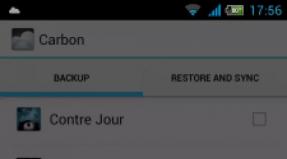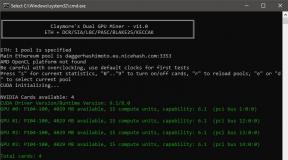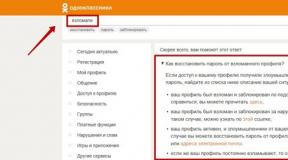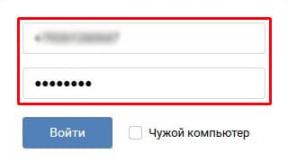Типы событий. Событие onclick javaScript и три способа обработки событий События onMouseOver и onMouseOut
Events are actions or occurrences that happen in the system you are programming, which the system tells you about so you can respond to them in some way if desired. For example, if the user clicks a button on a webpage, you might want to respond to that action by displaying an information box. In this article, we discuss some important concepts surrounding events, and look at how they work in browsers. This won"t be an exhaustive study; just what you need to know at this stage.
| Basic computer literacy, a basic understanding of HTML and CSS, JavaScript first steps . |
| To understand the fundamental theory of events, how they work in browsers, and how events may differ in different programming environments. |
As mentioned above, events are actions or occurrences that happen in the system you are programming - the system produces (or "fires") a signal of some kind when an event occurs, and also provides a mechanism by which some kind of action can be automatically taken (that is, some code running) when the event occurs. For example in an airport when the runway is clear for a plane to take off, a signal is communicated to the pilot, and as a result, they commence piloting the plane.
In the case of the Web, events are fired inside the browser window, and tend to be attached to a specific item that resides in it - this might be a single element, set of elements, the HTML document loaded in the current tab, or the entire browser window. There are a lot of different types of events that can occur, for example:
- The user clicking the mouse over a certain element or hovering the cursor over a certain element.
- The user pressing a key on the keyboard.
- The user resizing or closing the browser window.
- A form being submitted.
- A video being played, or paused, or finishing play.
- An error occurring.
You can gather from this (and from glancing at the MDN Event reference) that there are a lot of events that can be responded to.
Each available event has an event handler , which is a block of code (usually a JavaScript function that you as a programmer create) that will be run when the event fires. When such a block of code is defined to be run in response to an event firing, we say we are registering an event handler . Note that event handlers are sometimes called event listeners - they are pretty much interchangeable for our purposes, although strictly speaking, they work together. The listener listens out for the event happening, and the handler is the code that is run in response to it happening.
Note : Web events are not part of the core JavaScript language - they are defined as part of the APIs built into the browser.
A simple exampleLet"s look at a simple example to explain what we mean here. You"ve already seen events and event handlers used in many of the examples in this course already, but let"s recap just to cement our knowledge. In the following example, we have a single , which when pressed, makes the background change to a random color:
Change color
Button { margin: 10px };
The JavaScript looks like so:
Const btn = document.querySelector("button"); function random(number) { return Math.floor(Math.random() * (number+1)); } btn.onclick = function() { const rndCol = "rgb(" + random(255) + "," + random(255) + "," + random(255) + ")"; document.body.style.backgroundColor = rndCol; }
In this code, we store a reference to the button inside a constant called btn , using the Document.querySelector() function. We also define a function that returns a random number. The third part of the code is the event handler. The btn constant points to a element, and this type of object has a number of events that can fire on it, and therefore, event handlers available. We are listening for the click event firing, by setting the onclick event handler property to equal an anonymous function containing code that generates a random RGB color and sets the background-color equal to it.
This code is run whenever the click event fires on the element, that is, whenever a user clicks on it.
The example output is as follows:
It"s not just web pagesAnother thing worth mentioning at this point is that events are not unique to JavaScript - most programming languages have some kind of event model, and the way the model works often differs from JavaScript"s way. In fact, the event model in JavaScript for web pages differs from the event model for JavaScript as it is used in other environments.
Inline event handlers - don"t use theseYou might also see a pattern like this in your code:
Press me function bgChange() { const rndCol = "rgb(" + random(255) + "," + random(255) + "," + random(255) + ")"; document.body.style.backgroundColor = rndCol; }
The earliest method of registering event handlers found on the Web involved event handler HTML attributes (or inline event handlers ) like the one shown above - the attribute value is literally the JavaScript code you want to run when the event occurs. The above example invokes a function defined inside a element on the same page, but you could also insert JavaScript directly inside the attribute, for example:
Press me
You can find HTML attribute equivalents for many of the event handler properties; however, you shouldn"t use these - they are considered bad practice. It might seem easy to use an event handler attribute if you are just doing something really quick, but they very quickly become unmanageable and inefficient.
For a start, it is not a good idea to mix up your HTML and your JavaScript, as it becomes hard to parse - keeping your JavaScript all in one place is better; if it is in a separate file you can apply it to multiple HTML documents.
Even in a single file, inline event handlers are not a good idea. One button is OK, but what if you had 100 buttons? You"d have to add 100 attributes to the file; it would very quickly turn into a maintenance nightmare. With JavaScript, you could easily add an event handler function to all the buttons on the page no matter how many there were, using something like this:
Const buttons = document.querySelectorAll("button"); for (let i = 0; i < buttons.length; i++) { buttons[i].onclick = bgChange; } buttons.forEach(function(button) { button.onclick = bgChange; });
Note : Separating your programming logic from your content also makes your site more friendly to search engines.
addEventListener() and removeEventListener()The newest type of event mechanism is defined in the Document Object Model (DOM) Level 2 Events Specification, which provides browsers with a new function - addEventListener() . This functions in a similar way to the event handler properties, but the syntax is obviously different. We could rewrite our random color example to look like this:
Const btn = document.querySelector("button"); function bgChange() { const rndCol = "rgb(" + random(255) + "," + random(255) + "," + random(255) + ")"; document.body.style.backgroundColor = rndCol; } btn.addEventListener("click", bgChange);
Inside the addEventListener() function, we specify two parameters - the name of the event we want to register this handler for, and the code that comprises the handler function we want to run in response to it. Note that it is perfectly appropriate to put all the code inside the addEventListener() function, in an anonymous function, like this:
Btn.addEventListener("click", function() { var rndCol = "rgb(" + random(255) + "," + random(255) + "," + random(255) + ")"; document.body.style.backgroundColor = rndCol; });
This mechanism has some advantages over the older mechanisms discussed earlier. For a start, there is a counterpart function, removeEventListener() , which removes a previously added listener. For example, this would remove the listener set in the first code block in this section:
Btn.removeEventListener("click", bgChange);
This isn"t significant for simple, small programs, but for larger, more complex programs it can improve efficiency to clean up old unused event handlers. Plus, for example, this allows you to have the same button performing different actions in different circumstances - all you have to do is add or remove event handlers as appropriate.
Second, you can also register multiple handlers for the same listener. The following two handlers wouldn"t both be applied:
MyElement.onclick = functionA; myElement.onclick = functionB;
The second line overwrites the value of onclick set by the first line. This would work, however:
MyElement.addEventListener("click", functionA); myElement.addEventListener("click", functionB);
Both functions would now run when the element is clicked.
In addition, there are a number of other powerful features and options available with this event mechanism. These are a little out of scope for this article, but if you want to read up on them, have a look at the addEventListener() and removeEventListener() reference pages.
What mechanism should I use?Of the three mechanisms, you definitely shouldn"t use the HTML event handler attributes - these are outdated, and bad practice, as mentioned above.
The other two are relatively interchangeable, at least for simple uses:
- Event handler properties have less power and options, but better cross-browser compatibility (being supported as far back as Internet Explorer 8). You should probably start with these as you are learning.
- DOM Level 2 Events (addEventListener() , etc.) are more powerful, but can also become more complex and are less well supported (supported as far back as Internet Explorer 9). You should also experiment with these, and aim to use them where possible.
The main advantages of the third mechanism are that you can remove event handler code if needed, using removeEventListener() , and you can add multiple listeners of the same type to elements if required. For example, you can call addEventListener("click", function() { ... }) on an element multiple times, with different functions specified in the second argument. This is impossible with event handler properties because any subsequent attempts to set a property will overwrite earlier ones, e.g.:
Element.onclick = function1; element.onclick = function2; etc.
Note : If you are called upon to support browsers older than Internet Explorer 8 in your work, you may run into difficulties, as such ancient browsers use different event models from newer browsers. But never fear, most JavaScript libraries (for example jQuery) have built-in functions that abstract away cross-browser differences. Don"t worry about this too much at this stage in your learning journey.
Other event conceptsIn this section, we briefly cover some advanced concepts that are relevant to events. It is not important to understand these concepts fully at this point, but they might serve to explain some code patterns you"ll likely come across from time to time.
Event objectsSometimes inside an event handler function, you might see a parameter specified with a name such as event , evt , or simply e . This is called the event object , and it is automatically passed to event handlers to provide extra features and information. For example, let"s rewrite our random color example again slightly:
Function bgChange(e) { const rndCol = "rgb(" + random(255) + "," + random(255) + "," + random(255) + ")"; e.target.style.backgroundColor = rndCol; console.log(e); } btn.addEventListener("click", bgChange);
Here you can see that we are including an event object, e , in the function, and in the function setting a background color style on e.target - which is the button itself. The target property of the event object is always a reference to the element that the event has just occurred upon. So in this example, we are setting a random background color on the button, not the page.
Note : You can use any name you like for the event object - you just need to choose a name that you can then use to reference it inside the event handler function. e / evt / event are most commonly used by developers because they are short and easy to remember. It"s always good to be consistent - with yourself, and with others if possible.
e.target is incredibly useful when you want to set the same event handler on multiple elements and do something to all of them when an event occurs on them. You might, for example, have a set of 16 tiles that disappear when they are clicked on. It is useful to always be able to just set the thing to disappear as e.target , rather than having to select it in some more difficult way. In the following example (see useful-eventtarget.html for the full source code; also see it running live here), we create 16 elements using JavaScript. We then select all of them using document.querySelectorAll() , then loop through each one, adding an onclick handler to each that makes it so that a random color is applied to each one when clicked:
Const divs = document.querySelectorAll("div"); for (let i = 0; i < divs.length; i++) { divs[i].onclick = function(e) { e.target.style.backgroundColor = bgChange(); } }
The output is as follows (try clicking around on it - have fun):
Hidden example Useful event target example div { height: 100px; width: 25%; float: left; } for (let i = 1; i


















